If you are planning a road trip from Las Vegas to San Diego, there are several different ways to do it.
Go on a national park road trip, visiting both Death Valley National Park and Joshua Tree National Park on the drive. Or, you can spend some time in the Mojave National Preserve, which is home to a surprisingly wide variety of landscapes.
Southern California contains some of the largest areas of protected land in the USA. Death Valley is the largest national park in the contiguous United States. Anza-Borrego Desert State Park is the largest state park in California. And the Mojave National Preserve is the 3rd largest unit in the US park system within the contiguous United States (Death Valley is #1 and Yellowstone is #2).
In this guide, we lay out several different ways to plan your southern California road trip, depending on your interests and how much time you have.
About These Itineraries
In this guide, we list three different itineraries.
- Itinerary #1: Las Vegas, Death Valley, Joshua Tree National Park, Anza-Borrego Desert State Park, and San Diego
- Itinerary #2: Las Vegas, Mojave National Preserve, Joshua Tree, Anza-Borrego Desert State Park, and San Diego
- Itinerary #3: Las Vegas, Death Valley, Mojave National Preserve, Joshua Tree, Anza-Borrego Desert State Park, and San Diego
Each itinerary is point-to-point. They start in Las Vegas and end San Diego, but you can switch the direction, if you plan to start in San Diego.
The best time for a Las Vegas to San Diego road trip is from November through March, when temperatures are mild.
For these itineraries, a high clearance 4WD vehicle is ideal, if you want to explore some of the more remote areas of the national and state parks (Racetrack Playa in Death Valley, Berdoo Canyon in Joshua Tree, Aiken Mine Road in the Mojave National Preserve, and Wind Caves in Anza-Borrego Desert). You can do these itineraries with a standard vehicle, you will just have to skip a few sights along the way.
Itinerary #1: 10 Day Las Vegas to San Diego Road Trip with Death Valley
This 10-day itinerary is done point-to-point from Las Vegas to San Diego. It includes a visit to two national parks (Death Valley and Joshua Tree) as well as several state parks.
Day 1: Las Vegas
Day 2: Valley of Fire day trip from Las Vegas
Day 3: Red Rock State Park or more time in Las Vegas
Day 4: Death Valley National Park
Day 5: Death Valley National Park
Day 6: Drive to Joshua Tree National Park
Day 7: Joshua Tree National Park
Day 8: Anza-Borrego Desert State Park
Day 9: San Diego
Day 10: Fly Home

Las Vegas to San Diego road trip map: Las Vegas, Death Valley, Joshua Tree, Anza-Borrego Desert, and San Diego
Day 1: Arrive in Las Vegas
Try to plan your flight so you arrive in Las Vegas in the morning or early afternoon. This will give you some time in the second half of the day to explore Las Vegas.
In the airport, pick up your rental car and then get settled into your hotel. Spend the remainder of the day visiting the sights in Las Vegas.
For information on what to do, read our article Best Things to Do in Las Vegas. In this guide, we also have hotel recommendations and restaurant recommendations.
WHERE TO STAY: You will spend three nights in Las Vegas. Our favorite hotel in Las Vegas is The Cosmopolitan (the views of the strip are incredible!) but we also highly recommend Marriott’s Grand Chateau (this hotel gets rave reviews and is our top pick for families). We have also stayed at the Wynn, the Venetian, and Mandalay Bay and had great experiences at all of them. If you are looking for a budget hotel that gets good reviews, check out the Holiday Inn Club Vacations at Desert Club Resort.
Day 2: Valley of Fire Day Trip from Las Vegas
The Valley of Fire is one of our favorite state parks in the USA. This small park is filled with panoramic vistas, hiking trails, petroglyphs, scenic drives, and stunning red and pink rock formations.
It is located one hour northeast of Las Vegas. Valley of Fire State Park opens at sunrise and I recommend getting here as early as possible (and ideally, get here no later than 8 am, if you want to see some of the park with low crowds).
In our Guide to the Valley of Fire, we have a full list of things to do in the park, so I recommend referring to that now, to help you plan your visit. It also has a one-day itinerary that is done as a day trip from Las Vegas.

Fire Wave

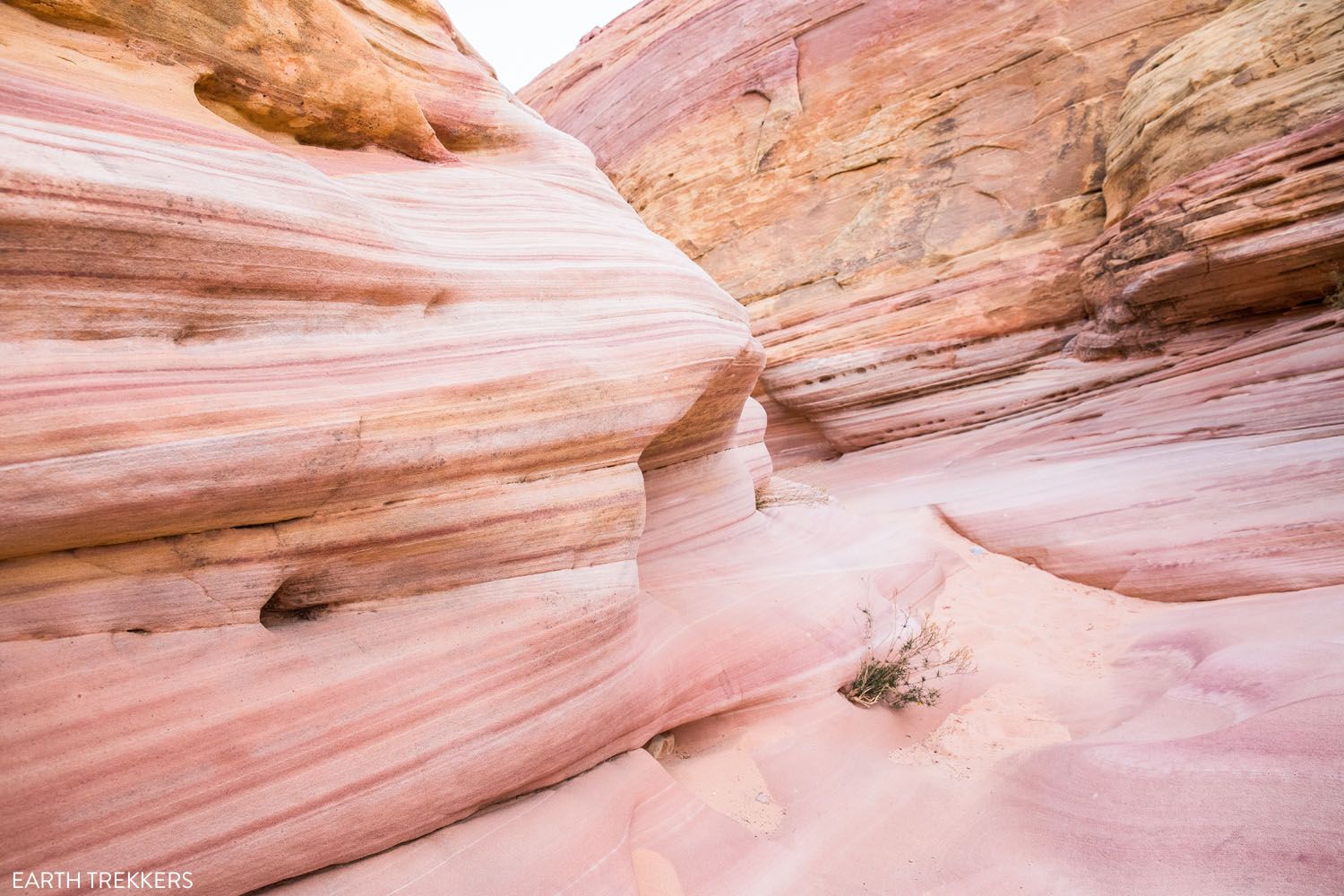
Pink Canyon, Valley of Fire
Expect to spend at least half of a day in the park but you can easily spend all day here, especially if you like hiking and/or photographing desert landscapes.
In the afternoon/evening, return to Las Vegas. Tonight is a great night to watch a show and go out to dinner.
Day 3: Red Rock State Park or More Time in Las Vegas
Red Rock Canyon is another stellar state park that makes a great day trip from Las Vegas. A visit here lasts a half to a full day, depending on how much hiking you want to do. Like the Valley of Fire, we recommend starting in the morning, to avoid the worst of the crowds.

Red Rock Canyon

Hiking in Red Rock Canyon
IMPORTANT: If you are planning your visit between October 1 and May 31, you will need to make a reservation to enter Red Rock Canyon. Learn more on the official website.
For recommendations on things to do in the park, read our Guide to Red Rock Canyon. We spent the morning in the park, hiking a few trails, and then spent the afternoon in Las Vegas.
If you have no desire to visit Red Rock Canyon, you have the full day to explore Las Vegas.
Day 4: Death Valley National Park
Death Valley is one of the most unusual national parks in the United States. With its barren salt flats, mysterious sailing stones, shifting sand dunes, slot canyons, and rainbow-colored mountains, there is a lot to do here.
On this itinerary, you have 2 days in Death Valley, which is just enough time to see the highlights. Below I list an overview on how to spend your time, but for more information, read our 2 Day Death Valley Itinerary.
Las Vegas to Death Valley
From Las Vegas it is a 2-hour drive to get to Death Valley. There are two routes to choose from: NV-160 through Pahrump and Death Valley Junction or US-95 through Indian Springs and Amargosa Valley. I recommend taking NV-160 through Pahrump. Overall, it’s a very scenic drive and it’s slightly quicker than driving on US-95.
In order to maximize your time in Death Valley (especially if you are visiting during the shorter winter days) get an early start. How early? If you leave Las Vegas at 7 am you will arrive in Death Valley at 9 am, which gives you plenty of time in the park today.
Pack a picnic lunch because there are very limited options for food once inside Death Valley National Park.
Death Valley Itinerary
Arrive in Death Valley. Take a photo at the park entrance sign if you like. At the pay station, pay your park fee (or, if you have an America the Beautiful Pass, you can skip this step).
Dante’s View. Just past the pay station, turn left on Furnace Creek Wash Road and take this to the very end to Dante’s View. From here, you have aerial views over Badwater Basin and Death Valley National Park.
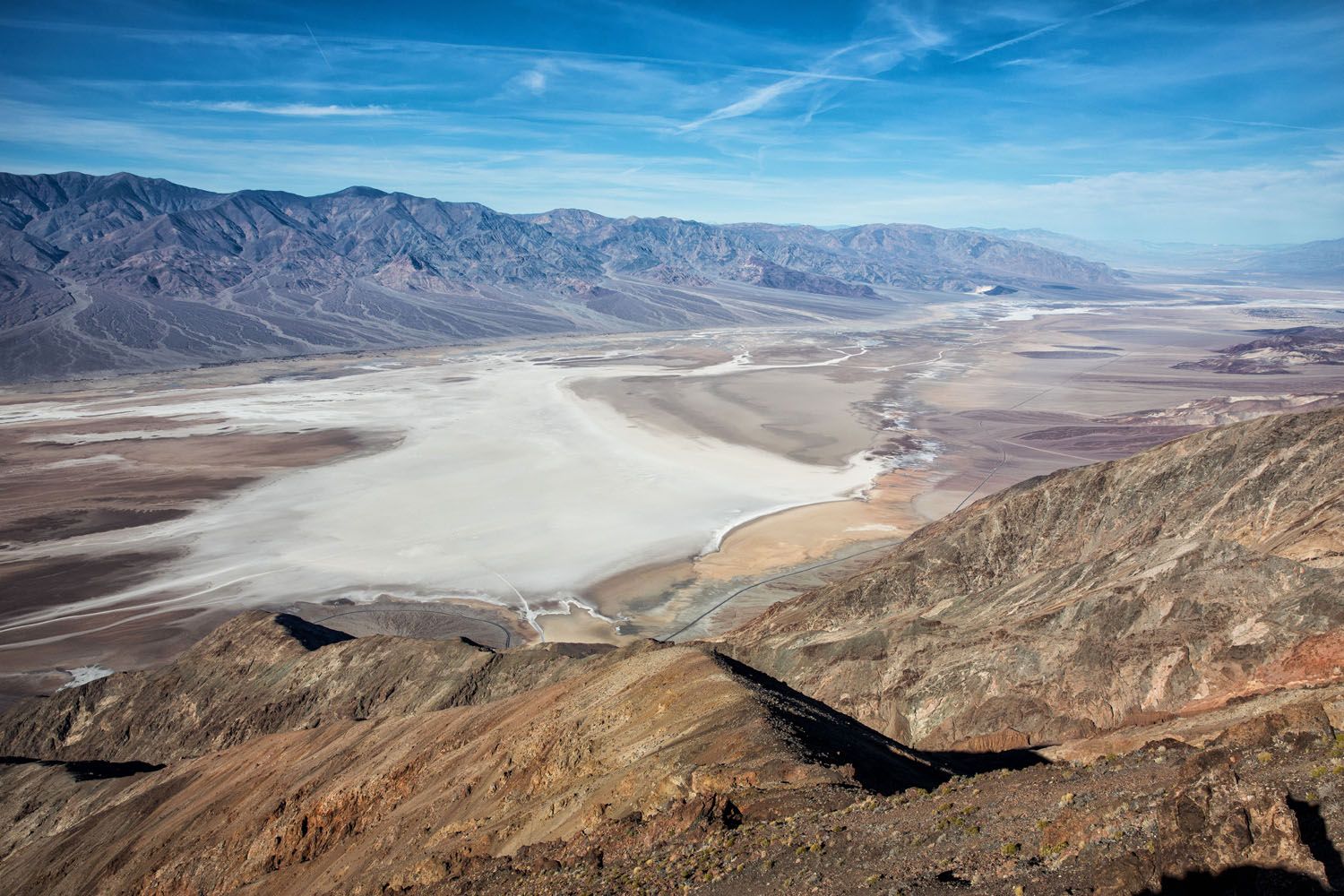
Dante’s View
Twenty Mule Team Canyon. Drive back to Highway 190 and turn left. Drive 6 miles to the entrance of Twenty Mule Team Canyon. This one-way road goes through yellow and white mudstone hills. It’s a short, beautiful drive with a few places to get out and hike up onto the hills for a different vantage point.
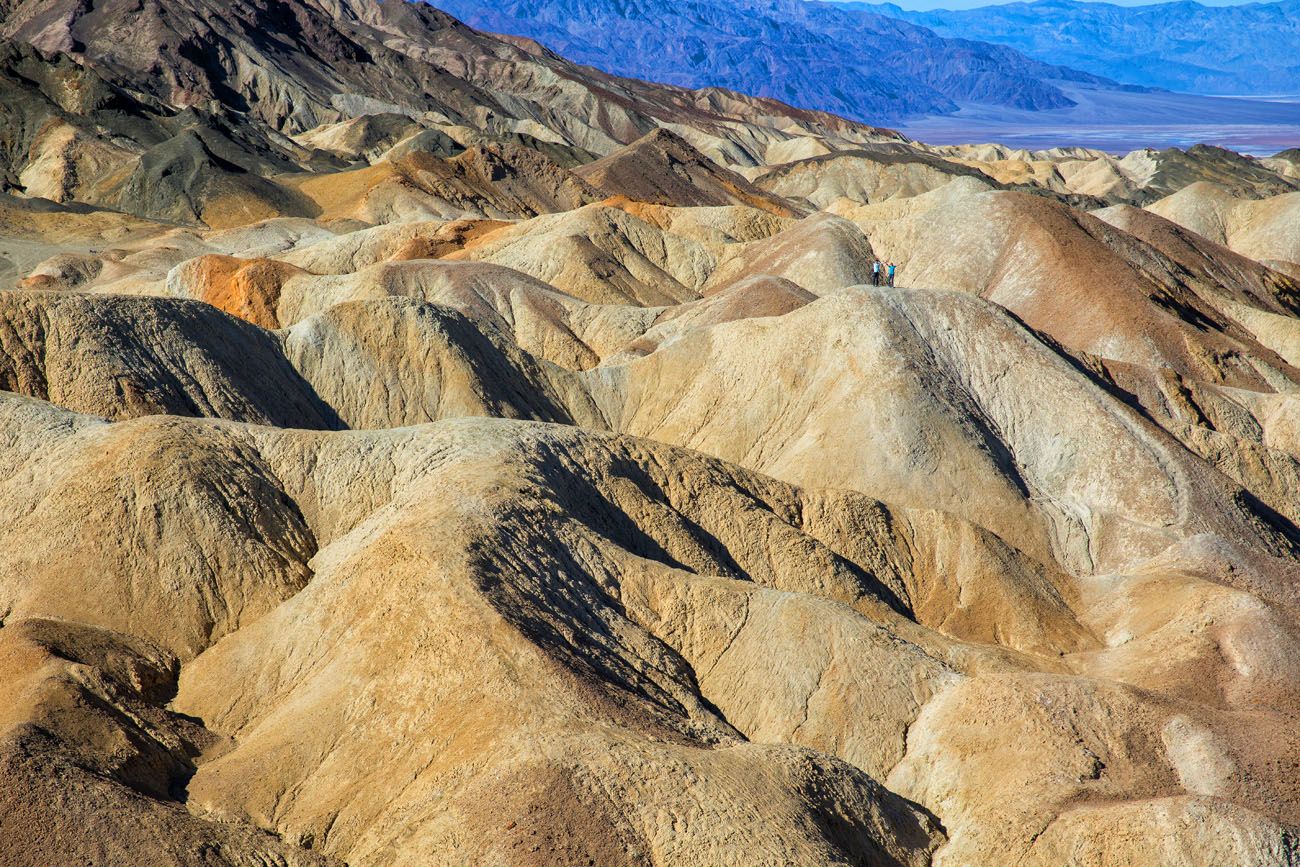
Twenty Mule Team Canyon
Zabriskie Point. Drive to Zabriskie Point. This is one of the most popular viewpoints in Death Valley.
Badwater Basin. Drive down Badwater Road and take the quick detour to the Devil’s Golf Course. Then continue the drive to Badwater Basin. This basin sits 282 feet below sea level, making it the lowest point in the United States. Walk out onto the salt flats and enjoy this unique landscape.

Badwater Basin
Artists Drive. This is a 9-mile scenic drive through more of Death Valley’s unique landscapes. Artists Drive is a one-way road from south to north. To get here from Badwater Basin, drive north on Badwater Road and turn right onto Artists Drive.
Golden Canyon – Gower Gulch Hike. This wonderful hike is 4.4 miles, takes 2 to 3 hours, and the trail winds through the badlands of Death Valley. Learn more in our Guide to Golden Canyon and Gower Gulch.

View along the Golden Canyon – Gower Gulch hike
Evening in Death Valley
In the evening, get dinner and check into your hotel.
In Death Valley, you can camp at the Furnace Creek Campground, The Oasis in Furnace Creek, or the Stovepipe Wells Hotel. You can also stay outside of the park in Beatty or Amargosa Valley (but note this will add a lot of unnecessary driving). We stayed in Stovepipe Wells and highly recommend it.
You will stay in Death Valley for two nights.
Death Valley has some of the darkest skies in the United States. The Mesquite Flat Sand Dunes, Badwater Basin, and Harmony Borax Works are all great places to view the night sky, if this sounds of interest to you.
Day 5: Death Valley National Park
There are three options on how to spend your day. You can either drive to Racetrack Playa to see the sailing stones (a high clearance 4WD is required), hike to Telescope Peak (a 4WD vehicle is recommended), or do shorter hikes in the park.
Racetrack Playa
Racetrack Playa is the place to see the mysterious sailing stones…the large rocks that somehow glide over this dry, sandy surface, leaving imprinted trails behind them.
Getting here is an adventure. From Furnace Valley Visitor Center, it is an 83-mile drive to get here. 27 of these miles are on rough, unpaved roads. It can take up to 3.5 hours to get to Racetrack Playa.
Once here, spend a few hours on the playa, photographing the sailing stones and hiking up onto the Grandstand for views over the area.

Racetrack Playa
How to Visit Racetrack Playa in Death Valley National Park
Everything you need to know to plan your visit to Racetrack Playa.After your visit to Racetrack Playa, visit the Mesquite Flat Sand Dunes.
Telescope Peak
At 11,043 feet (3,366 meters) Telescope Peak is the highest peak in the park. To get here, it is a tough hike…14 miles round trip with 3,000 feet (910 meters) of elevation gain. On average, it takes 7 hours to do this hike. But once at the top, you will have views of the lowest point in the USA, Badwater Basin, and the highest mountain peak in the contiguous United States, Mt. Whitney.
To get to the trailhead, the National Park Service recommends that you have a high clearance 4WD vehicle. Learn more here.
More Sights in Death Valley
If you don’t have a 4WD vehicle, or if you have no desire to journey out to Racetrack Playa or Telescope Peak, there are still plenty of things to do in Death Valley. Visit Ubehebe Crater and the Mesquite Flat Sand Dunes. If you like hiking, the Mosaic Canyon Trail and Grotto Canyon are located near Stovepipe Wells.

Ubehebe Crater

Mesquite Flat Sand Dunes
Alternatively, you could visit Mesquite Flat Sand Dunes first thing in the morning and use today to drive south to Joshua Tree National Park. That would make this itinerary one day shorter, or give you more time in Joshua Tree or San Diego.
Tonight, stay in Death Valley (unless you plan to leave the park early and drive to Joshua Tree National Park).
Day 6: Drive to Joshua Tree National Park
From Stovepipe Wells, it is a 5-hour drive to get to Joshua Tree National Park and there are several different routes to get there. I recommend taking the western route, which goes through Barstow, for different scenery on the drive (rather than driving through Las Vegas for a second time).
On this route, you will exit Death Valley in the west. As you drive out of the park, make a quick visit to see Darwin Falls.
As you head south, you can make a quick detour to see the Trona Pinnacles. These unique rock formations are located just south of Searles Valley.
Once in Twentynine Palms, get a bite to eat and then spend the afternoon in Joshua Tree National Park. Good things to do this afternoon include hiking the Hidden Valley Trail, seeing Skull Rock and hiking the Skull Rock Trail, and driving out to Keys View for the view of the Santa Rosa Mountains and San Jacinto Mountains.

Skull Rock

Keys View
Tonight, sleep in Twentynine Palms. We stayed at the Fairfield Inn & Suites and had a good experience. The Flying Point Homestead and 28 Palms Ranch get rave reviews and the Holiday Inn Express Hotel & Suites gets good reviews.
Day 7: Joshua Tree National Park
Spend the day in Joshua Tree National Park. For a full list of things to do, read our article Best Things to Do in Joshua Tree National Park.
Most of your time will be spent on Park Boulevard. The highlights of Joshua Tree National Park are clustered along this road. Hidden Valley and Skull Rock, which you had the option to visit yesterday, are located on this road.
First thing of the day, I recommend hiking the Hall of Horrors (a very short, scenic trail with the option to find and hike through a hidden slot canyon) or the Ryan Mountain Trail (a short, tough hike with a great view over the park). These two hikes are located very close together, so if you are an avid hiker, you have the option to do both of them.

Hall of Horrors Trail

Tim in the Hall of Horrors slot canyon
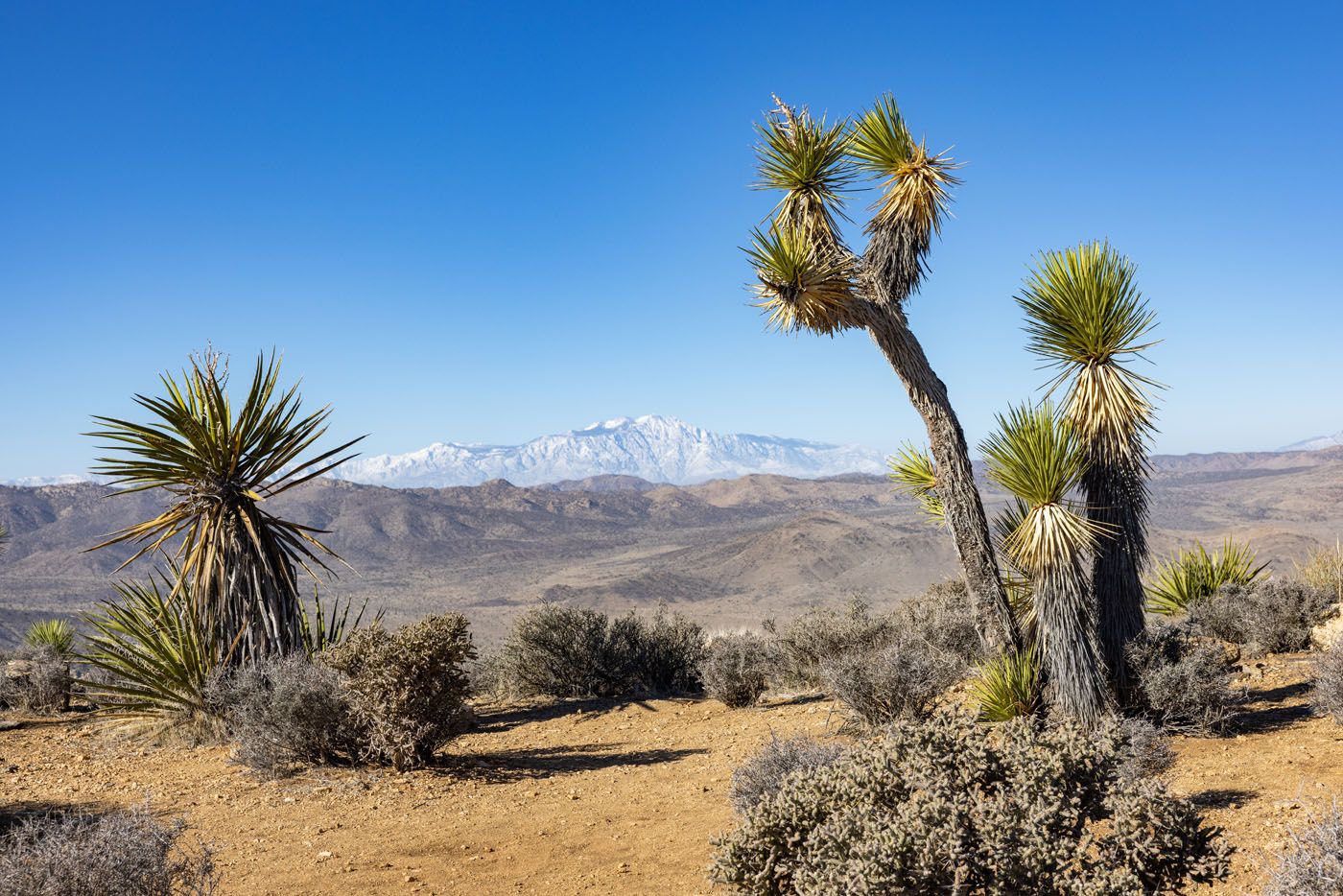
View from Ryan Mountain
Spend the rest of the day touring Joshua Tree: drive Geology Tour Road, visit Skull Rock, Hidden Valley, and Keys View if you did not do that yesterday, and then hike the Arch Rock Trail.

Arch Rock
Make a quick visit to the Cholla Cactus Garden and then head to the southern area of the park. If you still have energy left, hike through Cottonwood Spring to Mastodon Peak, another great hike in Joshua Tree National Park.
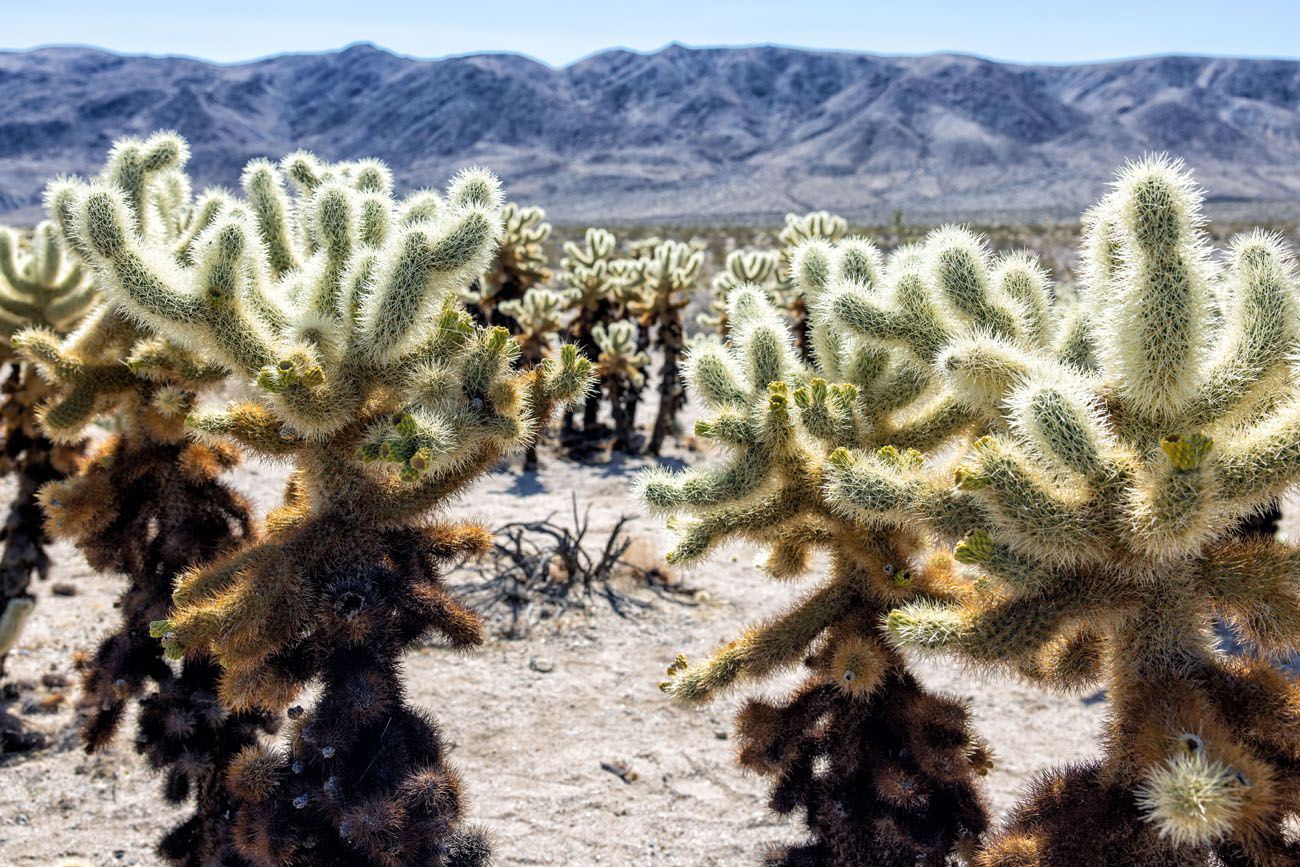
Cholla Cactus Garden

Mastodon Peak
Where to Stay
In the late afternoon, check into your hotel. We stayed in Palm Desert, which is a 45-minute drive from the southern entrance of Joshua Tree National Park. There are a lot of hotels and resorts to choose from in this area, not to mention a wide variety of restaurants.
I recommend staying in or near Palm Desert. Tomorrow, you tour Anza-Borrego Desert State Park, so it is best to stay southwest of Joshua Tree National Park tonight, to minimize how much driving you will do.
In Palm Desert, we stayed at the Westin Desert Willow Villas in Palm Desert. We had a great dinner at both the Pacifica Seafood Restaurant and Cork Tree California Cuisine. More dinner options include the Tommy Bahama Restaurant & Bar, Ristorante Mamma Gina, and Sherman’s Deli.
Day 8: Anza-Borrego Desert State Park
Anza-Borrego Desert State Park is the largest state park in California. With over 640,000 acres of land (according to the state park brochure), this is a massive state park. To put it into perspective, Anza-Borrego Desert State Park is twice the size of Grand Teton National Park and about four times the size of Zion National Park.
One day is all you need to see the highlights. Your day will start in Palm Desert, then you will road trip through Anza-Borrego, and end the day in San Diego.


Font’s Point

Palm Canyon
I recommend referring to our One Day in Anza-Borrego Desert State Park article for lots of important planning details (and more photos), but here is an overview on how to plan your time.
- 8:30 am: Hike The Slot, a short trail that goes through a slot canyon; it is our favorite experience in the park
- 9:30 am: Wind Caves (high clearance 4WD is required), a short hike up to the Wind Caves and great views of the park; if you don’t have a 4WD, skip ahead to the Cactus Loop Trail
- 10:40 am: Cactus Loop Trail
- 11:50 am: Galleta Meadows Sculptures
- 12:10 pm: Lunch in Borrego Springs
- 1:00 pm: Montezuma Valley Road Lookout
- 1:20 pm: Hike the Palm Canyon Trail (3-mile round trip hike to a desert oasis)
- 3:30 pm: Galleta Meadows Sculptures (area #2)
- 4:00 pm: Font’s Point (4WD required); scenic drive to one of the best overlooks in Anza-Borrego Desert State Park
- 5:00 pm: Drive to San Diego
From Font’s Point, it is a 2.25-hour drive to get to San Diego. It’s a slightly shorter drive if you skip Font’s Point and the second group of Galleta Meadows statues and start the drive from the Palm Canyon trailhead (2 hours, 85 miles).
Once in San Diego, check into your hotel and have dinner. You will spend two nights in San Diego.
Day 9: San Diego
Spend the day sightseeing in San Diego. Top things to do in San Diego include visiting Balboa Park (take your pick from the long list of museums here), go to the San Diego Zoo, visit Point Loma and Sunset Cliffs, tour the USS Midway Museum, and spend some time at the Torrey Pines Natural Reserve. La Jolla Cove is another nearby spot that is fun to visit.

Torrey Pines
In the evening, go out to dinner in the Gaslamp Quarter. Barleymash was by far our favorite restaurant in the Gaslamp Quarter. Serving craft beer, bourbon, and pizzas and burgers with an interesting spin, this place was amazing. Coming in as a close second was Basic, a pizza place that makes amazing pizza with fresh ingredients.
Day 10: Fly Home
Today, fly home, spend more time in San Diego, or continue on to your next destination.
Itinerary #2: 10 Day Las Vegas to San Diego Road Trip with Mojave National Preserve
This itinerary is similar to itinerary #1, with one big exception. I swapped out Death Valley National Park and added in Mojave National Preserve. Since you are now taking a more direct route to San Diego, driving distances are lower and you have more time in Joshua Tree National Park.
Which one is better? If you have never been to Death Valley, I recommend itinerary #1. Death Valley is unexpectedly awesome and one of our favorite national parks, so it’s well worth the time and extra driving. However, if you have visited Death Valley in the past, want to spend more time in Joshua Tree, or prefer a road trip with a little less driving, then itinerary #2 is worth considering. The Mojave National Preserve may not be as famous or as popular as Death Valley, but there are still some wonderful things to do here.
Day 1: Las Vegas
Day 2: Valley of Fire day trip from Las Vegas
Day 3: Red Rock State Park or more time in Las Vegas
Day 4: Mojave National Preserve
Day 5: Joshua Tree National Park
Day 6: Joshua Tree National Park
Day 7: Joshua Tree National Park
Day 8: Anza-Borrego Desert State Park
Day 9: San Diego
Day 10: Fly Home
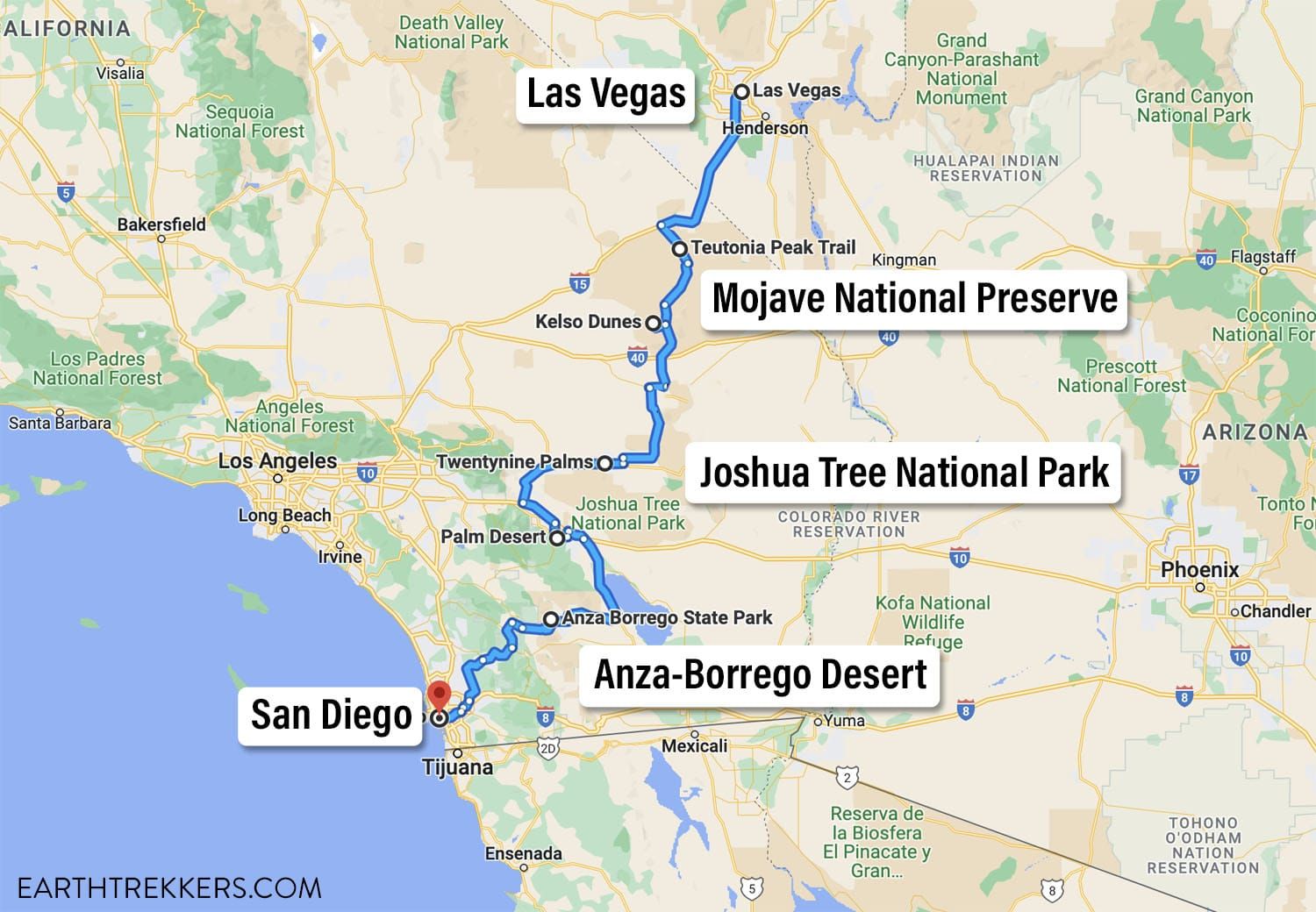
Las Vegas to San Diego road trip map: Las Vegas, Mojave National Preserve, Joshua Tree, Anza-Borrego Desert, and San Diego
Days 1, 2, 3: Las Vegas + Day Trips
These days are exactly the same as itinerary #1. If you want to refer back to those days, here are links:
Day 4: Mojave National Preserve
Today, drive from Las Vegas to Twentynine Palms, visiting the Mojave National Preserve on the way. From Las Vegas, take I-15 South.
Seven Magic Mountains
Just southwest of Las Vegas is a large-scale outdoor art exhibit called the Seven Magic Mountains. It was originally planned to be a temporary exhibit, but due to its enormous success, it is still open to visitors. This site is free to visit and it is located about 30 minutes south of Las Vegas on Interstate 15.
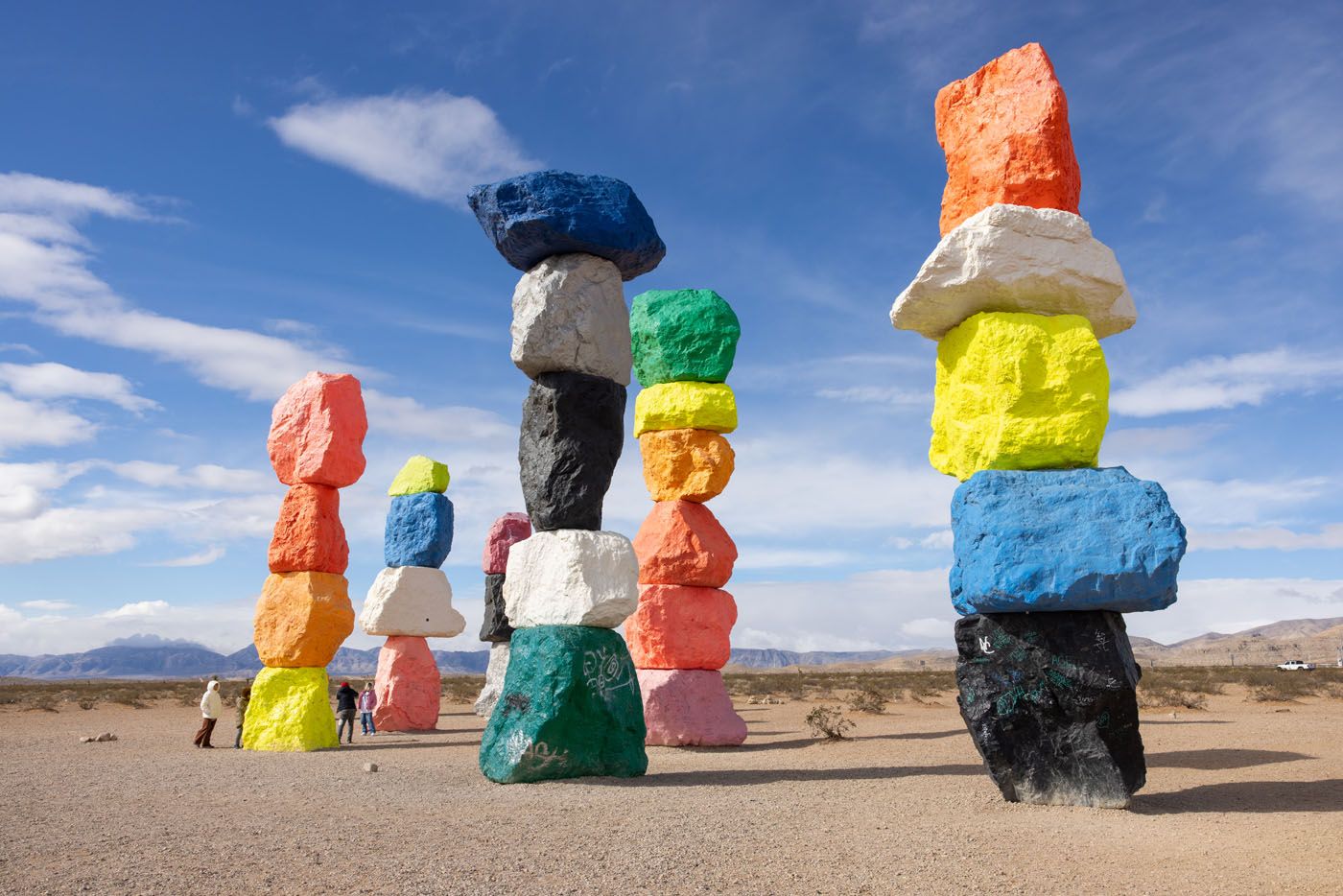
Seven Magic Mountains
Mojave National Preserve
The Mojave National Preserve is home to the largest concentration of Joshua Trees in the world. There are more Joshua Trees here than in Joshua Tree National Park.
While in the Mojave National Preserve, not only do you get to see these forests of Joshua Trees, but you can also go hiking, walk on sand dunes, visit historical sites, and drive through a volcanic area filled with cinder cones.
Not far past the Nevada – California border is the first entrance into the Mojave National Preserve. Turn left onto Cima Road. It doesn’t take long until you are driving through a forest of Joshua Trees. Unfortunately, many of these were badly burned in a forest fire in 2020.
10 EPIC Things to Do in Mojave National Preserve
For a full list of things to do, plus maps and many more photos, take a look at this guide to Mojave National Preserve.Teutonia Peak Trail
If you like hiking, and if you want to see more Joshua Trees, the Teutonia Peak Trail is a 3.25-mile out-and-back hike that takes you to the top of Teutonia Peak, for very nice views of the preserve. You also get to see quite a few Joshua Trees along the trail.

Joshua Trees along the Teutonia Peak Trail.
This is a moderately strenuous hike that takes between 1.5 and 3 hours. The trailhead is located on Cima Road.

View from Teutonia Peak
Once finished the hike, continue down Cima Road for less than a mile to see the White Cross World War I Memorial, a memorial cross that commemorates American war veterans.
Kelso Depot
The Kelso Depot is an old railroad depot that dates back to the early 20th century. It was placed on the National Register of Historic Places and in 2005 it became the visitor center for Mojave National Preserve. The area is also home to the Kelso ghost town. The visitor center is closed at least until 2023 but you can still see the historic buildings.
There are two ways to get here, depending on the type of vehicle you are driving.
With a high clearance 4WD vehicle
From the Teutonia Peak Trailhead, drive Cima Road towards I-15. Just before you reach I-15, look for a left hand turn onto Aiken Mine Road. This is a gravel, sandy road and a high clearance 4WD is required for this road. It heads south through a volcanic landscape and looks much different than what you saw on Cima Road.

Lava Tube Trail
Along the drive, you have the option to hike the Lava Tubes Trail, an easy half-mile hike that takes you to a lava tube.
Take Aiken Mine Road to Kelbaker Road and then turn left to go to the Kelso Depot. Kelbaker Road is a paved road.
Without a high clearance 4WD vehicle
Continue to drive Cima Road southeast (away from I-15). Cima Road meets Kelso Cima Road. Turn right here and take Kelso Cima Road to the Kelso Depot. Along the drive you can stop and see the Mojave Road Historical Marker.
Kelso Dunes
The Kelso Dunes are the most popular hiking destination in the Mojave National Preserve. To get to the top, it is a short but tough hike.
To get here, drive south on Kelbaker Road from the Depot. Turn right onto Kelso-Dunes Road to get to the trailhead and parking lot.
For those who don’t want to go that far, you can hike a short distance into the dunes and explore the lower dunes. But if you want to stand on the highest dune, it is a strenuous, 3 mile out-and-back hike from the parking lot.
Get the full details on the hike, and see the elevation profile, in our article about the Best Things to Do in the Mojave National Preserve.

Kelso Dunes
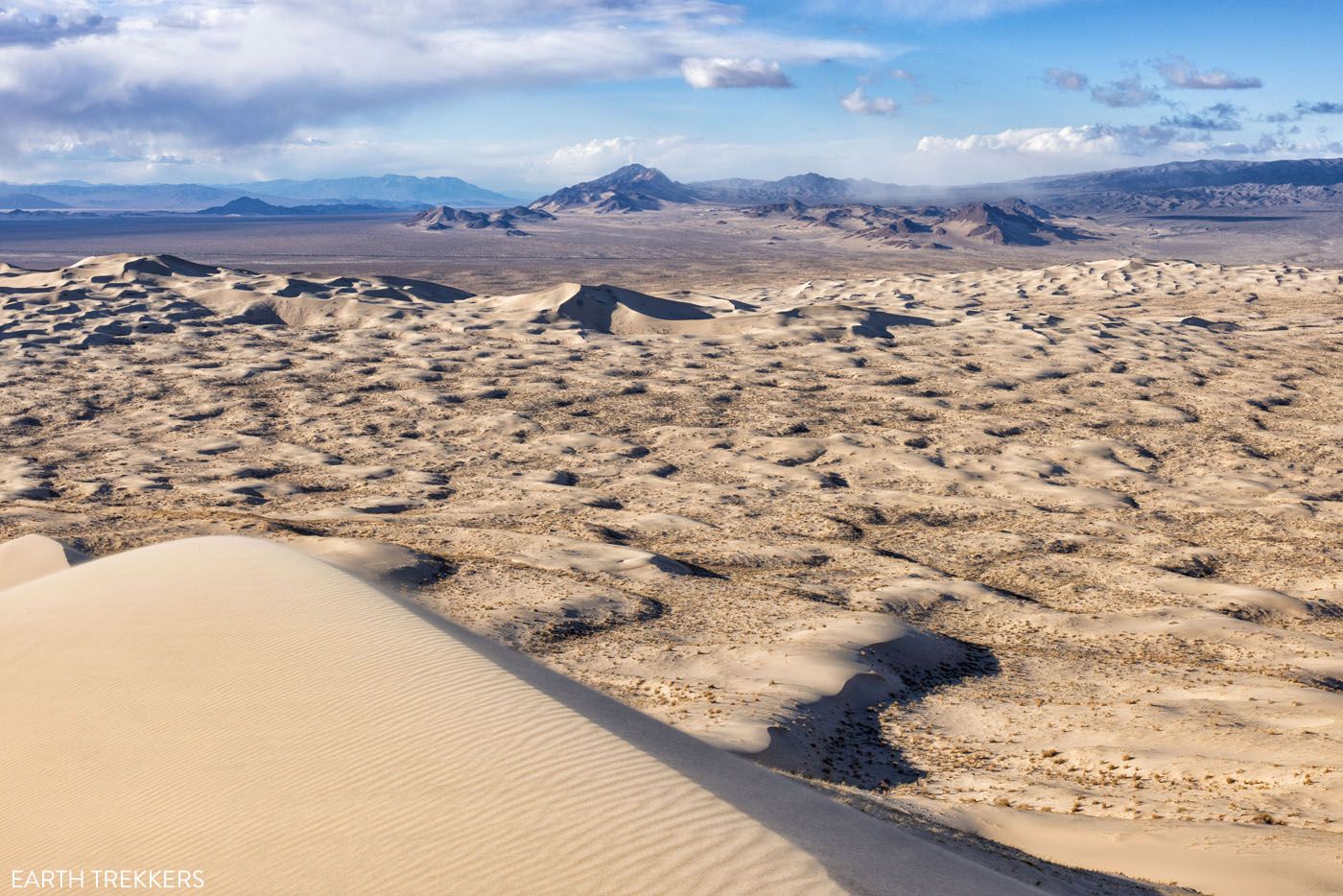
View from Top of Kelso Dunes
Boulders Viewpoint
From the Boulders Viewpoint, which is located on Kelbaker Road, you get a view of giant piles of boulders. These stacks of boulders look very similar to the scenery in Joshua Tree National Park. You can simply take in the view from the parking lot or walk the short trail for a closer view.
At this point, you are near the southern exit of the Mojave National Preserve. From here, you can drive to Twentynine Palms or add on one more short but very cool hike.
Optional: Hole-in-the-Wall Rings Trail
This easy hike is lots of fun. The scenery is much different than other areas of the preserve, and with the added bonus of rock scrambling up the rings, this hike is fun to do.
This hike is a 1.4-mile loop, is rated as easy, and takes 30 to 60 minutes. For full details on the hike, read our article about the Mojave National Preserve.

Hole-in-the-Wall Rings Trail
The hike is short but the drive to get here is long, so this is only worthwhile if you are doing very well on time. To get here from Boulders Viewpoint, it takes just under an hour. You will head east on I-40, turn left onto Essex Road, then right onto Black Canyon Road. The Hole-in-the-Wall trailhead is located on the left-hand side of Black Canyon Road, about 10 miles north of the junction with Essex Road.
Drive to Twentynine Palms
If you chose to hike the Hole-in-the-Wall trail, it is a 2-hour drive (110 miles) to Twentynine Palms.
If you skipped the hike, it is a 1.25-hour drive (75 miles) from the Boulders Viewpoint area to Twentynine Palms.
Once in Twentynine Palms, have dinner and check into your hotel. You will stay in Twentynine Palms for two to three nights.
Day 5: Joshua Tree National Park
On this itinerary, you have 3 full days to explore Joshua Tree National Park. That’s the same amount of time as we had, which is great if you like hiking and want to explore all the corners of the park.
For some people, 3 days in Joshua Tree may be too much time. You can eliminate 1 or 2 of these days, to shorten the itinerary, or use that time to do something else (more time in Las Vegas, San Diego, or Palm Desert).
The 3-day Joshua Tree itinerary that I am about to lay out is our exact itinerary. It has a big emphasis on hiking and for some parts of the park, you will need a 4WD vehicle. I am going to list everything we did, with timing, and for full details on each hike/experience, refer to our Things to Do in Joshua Tree guide and our Best Hikes in Joshua Tree guide.
- 8:00 am: Hike the Ryan Mountain Trail
- 10:00 am: Hall of Horrors Hike
- 11:30 am: Keys View
- 11:45 am: Cap Rock Nature Trail
- 12:30 pm: Hidden Valley Trail
- 1:30 pm: We had a tour of Keys Ranch scheduled this afternoon, but it was cancelled.
- 1:30 pm: Barker Dam Trail
- 2:30 pm: Rock scrambling around Skull Rock
- 3:00 pm: Split Rock Trail
- 4:30 pm: Oasis of Mara
That is a lot of hiking. Things on this list I recommend skipping are the Barker Dam Trail and the Split Rock Trail. The Oasis of Mara is not very exciting and you can see better oases in the upcoming days. There are picnic areas near Hidden Valley and this would be a nice place to relax and spend an hour or two midday.
Tonight, sleep in Twentynine Palms.

Joshua Trees along the Hall of Horrors Trail
Day 6: Joshua Tree National Park
- 8:00 am: Fortynine Palms Oasis hike
- 10:30 am: Warren Peak hike
- 1:00 pm: We drove to Eureka Peak. It’s similar to Keys View but better, since it is located in a remote part of the park. We were the only ones here when we did this. However, to do this drive, you must have a high clearance 4WD.
- 3:00 pm: Noah Purifoy Outdoor Desert Art Museum. This small, outdoor museum is located north of the town of Joshua Tree. It’s a quirky museum with sculptures make from bicycles, old TV’s, and even toilet seats.
- 3:30 pm: Drive to Palm Desert or return to Twentynine Palms

Fortynine Palms Oasis

View from Warren Peak
Tonight, you have an option on where to stay. If you have a 4WD and experience driving on rough, rugged unpaved roads, you can stay in Palm Desert and tomorrow, drive through Berdoo Canyon to enter Joshua Tree National Park. If you don’t have a 4WD, or have no desire to drive Berdoo Canyon, spend a third night in Twentynine Palms.
Day 7: Joshua Tree National Park
Starting from Palm Desert
- 8 am: Drive Berdoo Canyon Road, the most adventurous entrance into the park. This rugged, rough, unpaved road heads through Berdoo Canyon, cutting through the San Bernardino Mountains. It is about 15 miles long and to drive this road, you must have a high-clearance 4WD vehicle and experience driving on 4WD roads. There are several sections where you will have to drive over obstacles in the road, such as large boulders or very rocky, rugged sections of road.
- 9 am: Geology Tour Road. Berdoo Canyon Road ends at Geology Tour Road. Drive Geology tour road and then continue the drive to Park Boulevard.
- 10:00 am: Skull Rock Trail
- 11:30 am: Arch Rock Trail
- 1:00 pm: Cholla Cactus Garden
- 1:45 pm: Mastodon Peak Trail
- 3:30 pm: Drive to Palm Desert
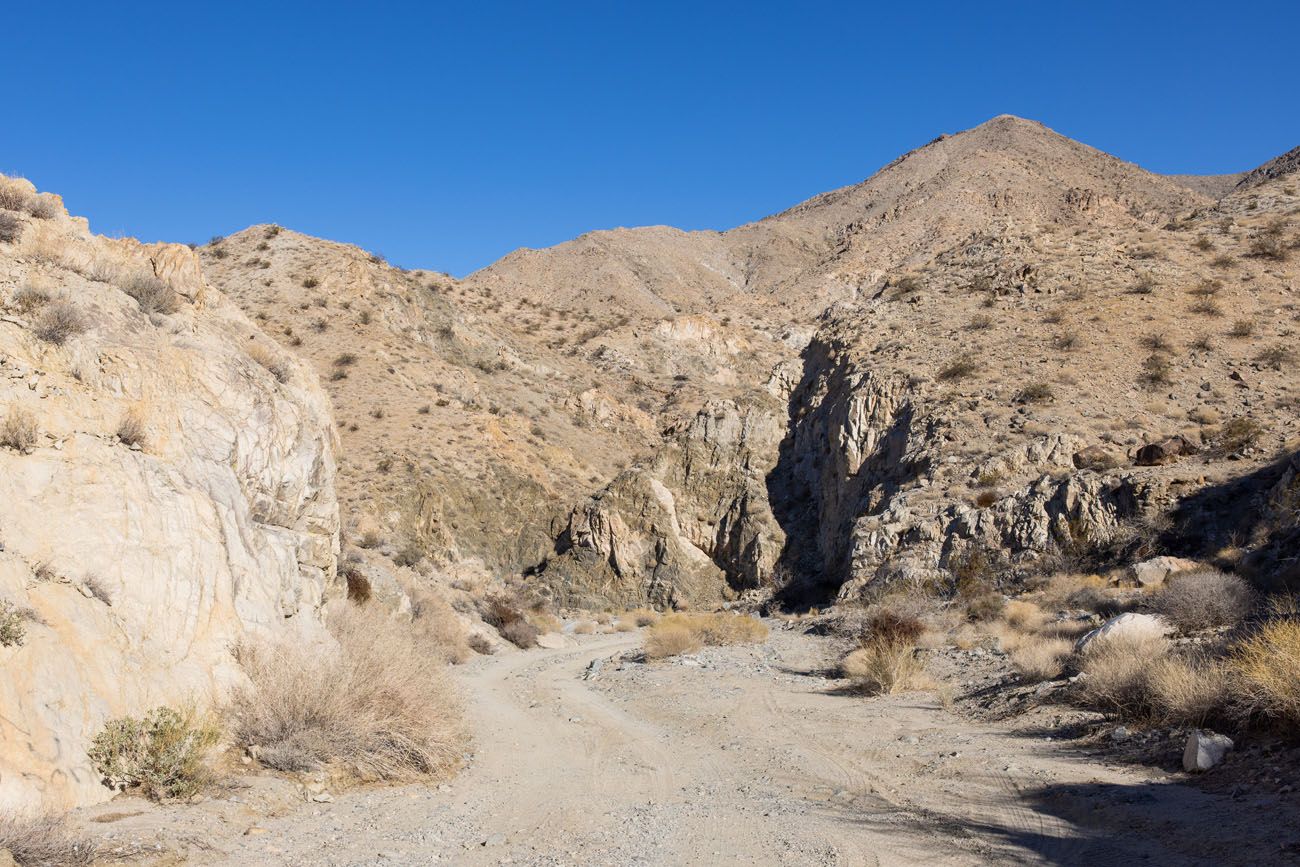
Berdoo Canyon
Starting from Twentynine Palms
- 8:00 am: Skull Rock Trail
- 9:30 am: Geology Tour Road
- 10:45 am: Arch Rock Trail
- 12:15 pm: Cholla Cactus Garden
- 1:00 pm: Mastodon Peak Trail
- 2:45 pm: Drive to Palm Desert
Tonight, stay in Palm Desert.

Skull Rock Trail
Days 8, 9 & 10: Anza-Borrego & San Diego
These days are exactly the same as itinerary #1. If you want to refer back to those days, here are links:
Itinerary #3: Las Vegas, Death Valley, Mojave National Preserve, Joshua Tree & Anza-Borrego Desert
For one epic road trip, you can visit Death Valley, the Mojave National Preserve, Joshua Tree, and Anza-Borrego Desert, and you only need to add one more day.
Day 1: Arrive in Las Vegas
Day 2: Valley of Fire day trip
Day 3: Red Rock Canyon or more time in Las Vegas
Day 4: Death Valley National Park
Day 5: Death Valley National Park (sleep in Las Vegas)
Day 6: Mojave National Preserve
Day 7: Joshua Tree National Park
Day 8: Joshua Tree National Park
Day 9: Anza-Borrego Desert State Park
Day 10: San Diego
Day 11: Fly home

Southern California road trip map
Planning Your Trip
National & State Park Fees
Here are the fees to enter each park.
Death Valley National Park: $30 per vehicle, valid for 7 days
Joshua Tree National Park: $30 per vehicle, valid for 7 days
Mojave National Preserve: free
Anza-Borrego Desert State Park: $10 per vehicle per day
Valley of Fire State Park: $10 per vehicle in-state; $15 per vehicle out-of-state
Red Rock Canyon: $15 per vehicle
America the Beautiful Pass
This annual park pass costs $80 and is valid for one year. It gives you free admission to any national park or federal recreation sites that you visit within 365 days of purchasing this pass.
On this itinerary, the America the Beautiful Pass covers your admission into Death Valley, Joshua Tree, and Red Rock Canyon. If you add these up, the total is $75, so you almost break even by purchasing the America the Beautiful Pass. However, if you plan to visit any other national park unit within 365 days, there is a good chance that you will get free admission into that park.
Valley of Fire State Park and Anza-Borrego Desert State Park are not included with this pass since they are state parks.
Important Links
- Death Valley National Park
- Joshua Tree National Park
- Mojave National Preserve
- Anza-Borrego Desert State Park
- Valley of Fire State Park
- Red Rock Canyon
If you have any questions about this Las Vegas to San Diego road trip, let us know in the comment section below.
More Information for Your Trip to California & Nevada
We have more information about things to do in California in our California Travel Guide. If this is part of a bigger road trip through the USA, you can read all of our articles about the United States in our United States Travel Guide.







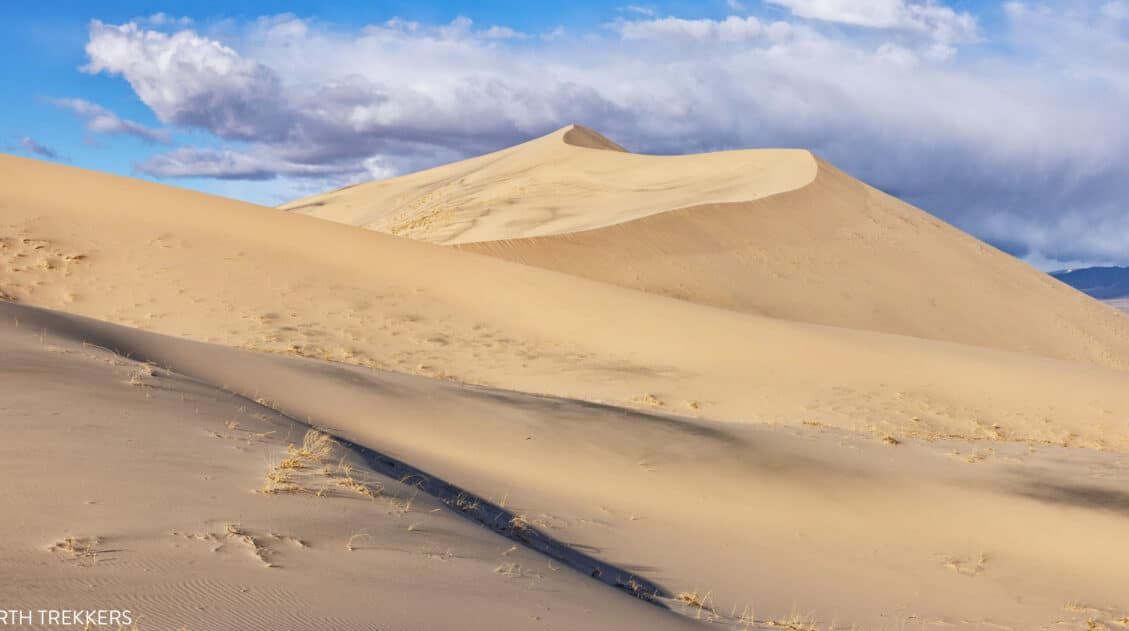






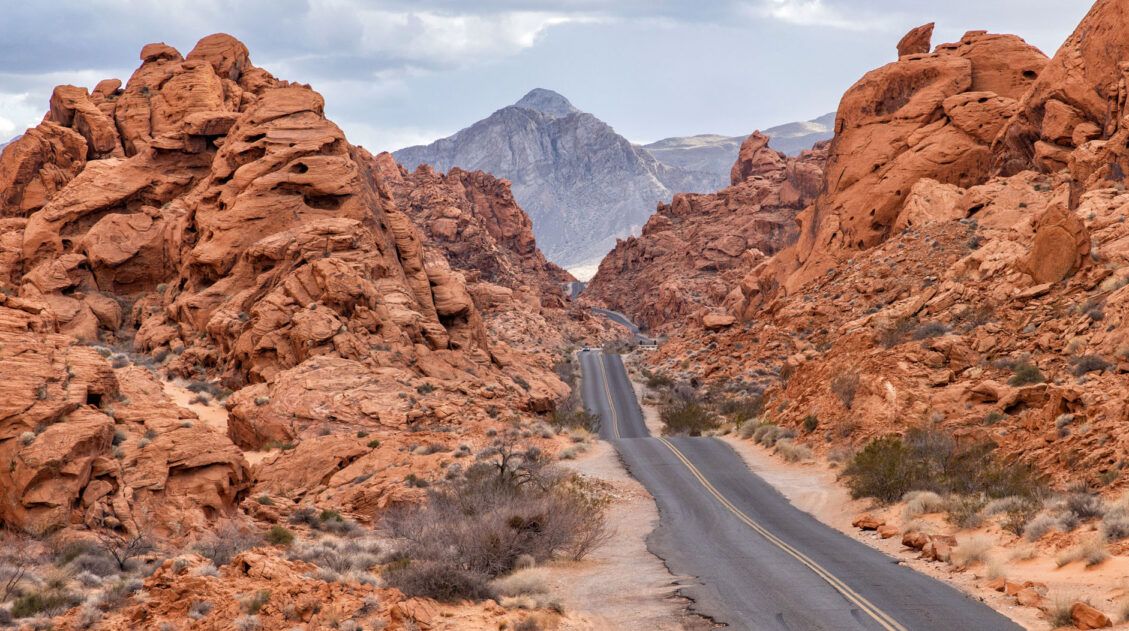



Comments 2